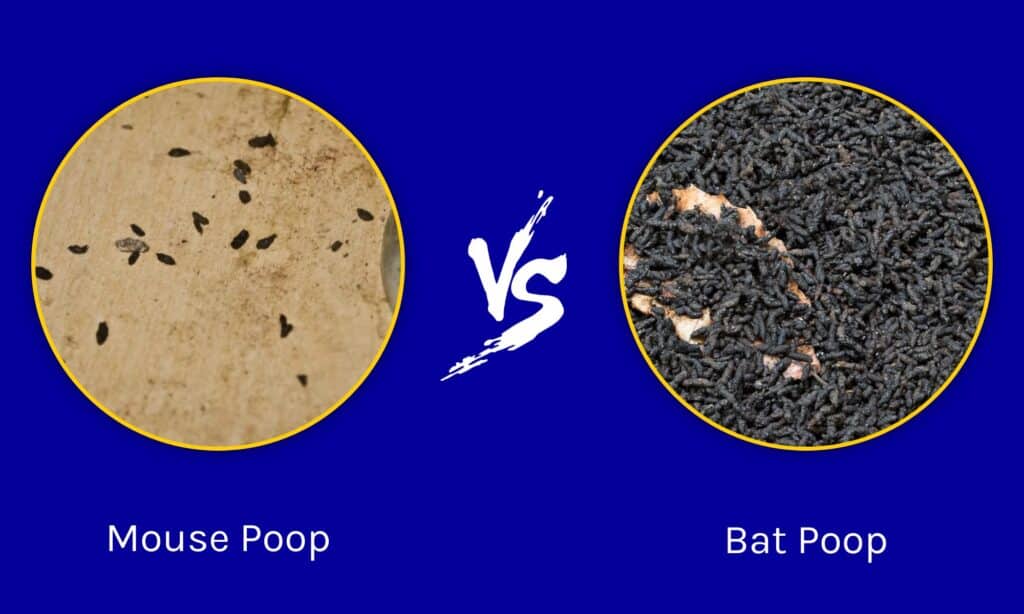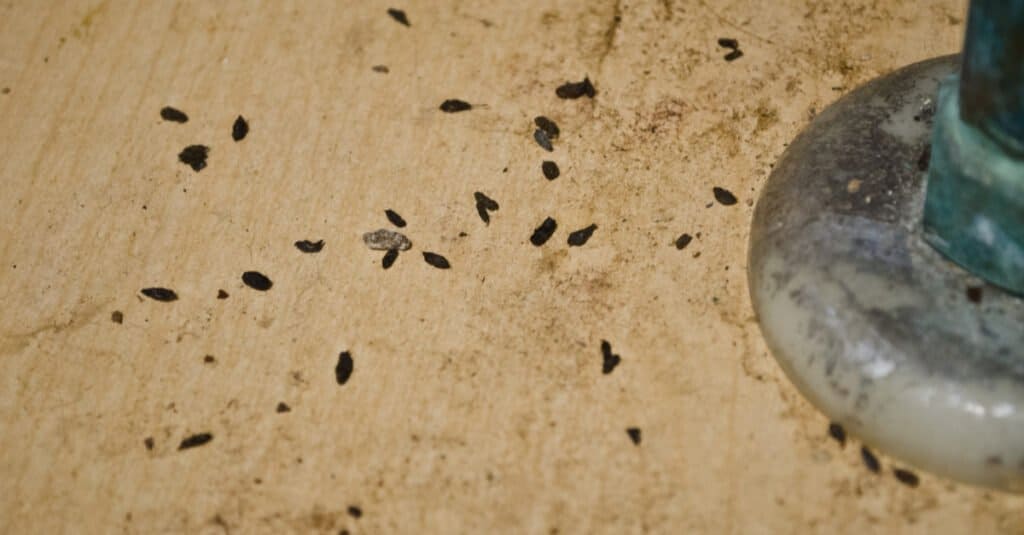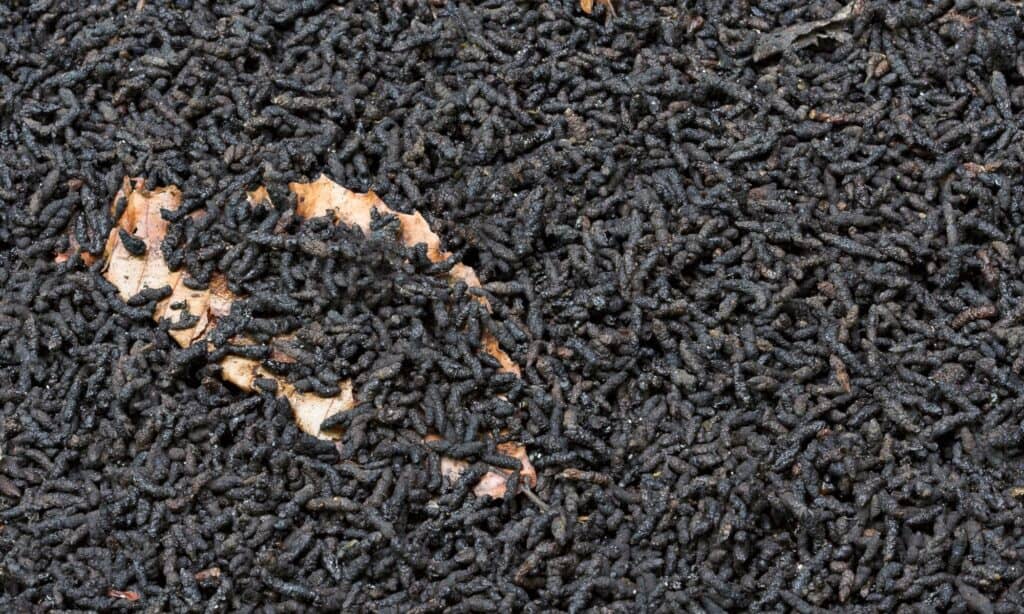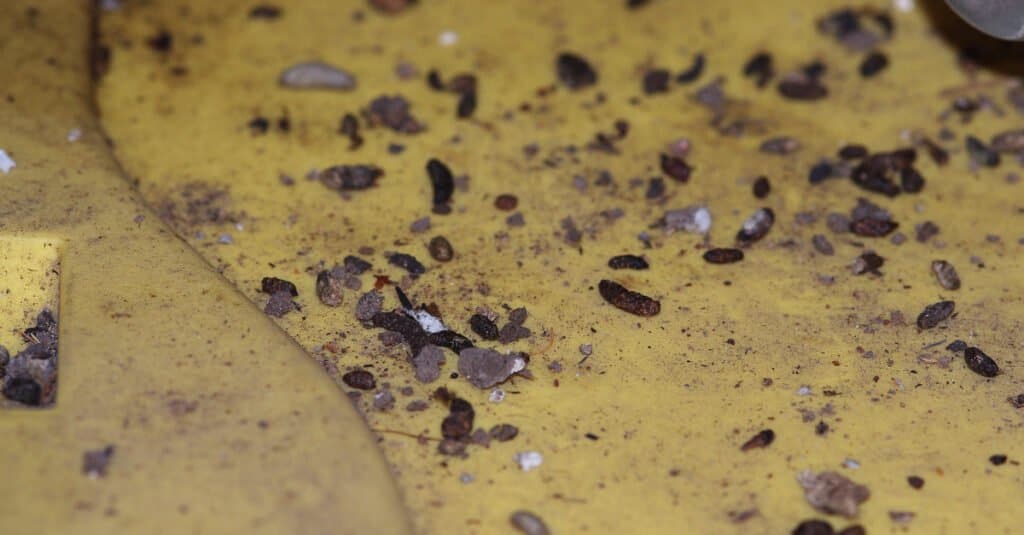The droppings of bats are remarkably like that of mice, which is why they’re often mistaken for one another. They both appear black and roughly the same size and shape. But when it comes to bat poop vs. mouse poop there are a handful of differences. Knowing what details to look for while dealing with an infestation is critical, especially if you’ve never dealt with one before. Here’s everything you need to know about mouse poop vs. bat poop.
Mouse Poop vs. Bat Poop: A Comparison

If you’re trying to tell the difference between mouse and bat droppings, you need to begin by pressing on them (using gloves, of course).
Bat droppings will crumble into a powder because they are solely made up of insects, whereas mouse droppings are pasty when fresh and grow harder as they dry out.
Additionally, here are a few key differences:
| MOUSE DROPPINGS | BAT DROPPINGS | |
|---|---|---|
| Size | Length ⅛ to ¼ inch | Length ¼ to ½ inch |
| Color | Black; Old Droppings Are Dull, But New Droppings Shine | Blackish in color, even old droppings glisten |
| Shape | One or both ends pointed | Ends blunt, not pointed |
| Texture | Fresh droppings are soft with a putty-like texture | Fresh droppings break and crumble easily |
| Components | Often contain rodent hairs | Shiny insect parts easily seen |
| Location | All Over; Scattered | In Attics/Small Spaces; Found In Piles |
| Danger Level | Hantavirus | Fungal Diseases |
The Key Differences Between Mouse Poop and Bat Poop
The key differences between mouse poop and bat poop fall into the categories of appearance and characteristics.
Let’s explore these in detail!
Appearance

Mouse droppings are around a quarter of an inch.
©Pegasene/Shutterstock.com
Size
A mouse’s droppings are around a quarter of an inch. The size and shape of bat droppings are comparable to those of a mouse’s (approximately 1/3 inch).
Color
It’s common for bat excrement to be shiny and black. Meanwhile, fresh mouse droppings appear wet, slick, and black when they’re fresh. Stale-looking mouse droppings that have been sitting around for a lengthy period are gray in color.
Shape
House mice excrete cone-shaped droppings with a pointed tip. Bat droppings are elongated and have blunt ends.
Characteristics

Bat poop is typically shiny, black, and contains insect parts.
©iStock.com/sbonk
Texture
The age of the mouse droppings might tell you if the infestation is ongoing. Fresh mouse feces are sticky and slimy. Bat guano is glossy but crumbles when it’s broken down.
Components
The discrepancy in droppings is due to the animals’ diet. Because bats eat insects, they leave shiny insect bits in their droppings. Since the droppings have undigested pieces of bugs, they crumble readily. While insect pieces may be found in mouse droppings too, insects are not their preferred food. Mouse excrement mostly contains mouse hairs from grooming.
Location
Bat droppings are usually found in piles, whereas mouse poop is usually scattered. A single mouse can leave up to 70 droppings every day scattered about! Most mouse droppings are found near (but not in) mouse nests and feeding areas.
Large numbers of bats roosting in an attic for a lengthy period are common causes of bat-dropping buildup. Many older homes lack attic floor insulation. An abundance of bat guano and urine in the attic can stain the ceilings of your home.
Danger Level
Fungal diseases are spread through bat droppings. The main worry is histoplasmosis. Histoplasmosis is caused by inhaling fungus spores found in bird or bat droppings. Human exposure occurs when disrupted droppings become airborne during cleanup. Most people do not get sick from inhaling spores. However, a lung infection with flu-like symptoms in some people could also progress to a deadly chronic condition that resembles tuberculosis. Histoplasmosis capsulatum spores typically form in three-year-old droppings.
Mouse feces can transmit bacteria, taint food, and cause allergic reactions in humans. Dry feces pose a risk to those who inhale the particles. This can happen while cleaning. Mouse droppings can also spread illnesses and viruses, such as Hantavirus. Symptoms begin one to eight weeks after contact exposure. Early symptoms include weariness, fever, and muscle aches. Nausea, vomiting, diarrhea, and stomach pain may also occur. These symptoms affect almost half of HPS patients. The late symptoms of HPS emerge four to 10 days after first symptoms. Coughing and shortness of breath are symptoms of lungs filling with liquid. HPS is deadly, with a 38% fatality rate. In case of exposure to mouse droppings and any of the symptoms listed above, seek medical attention immediately.
Bonus: How Do I Tell Mice Scat and Rat Scat Apart?
In general, a mouse scat is a compact, small pellet with tapered ends similar to a grain of rice, and is dark brown or black in color. Rat poop is more sausage-like in shape, measuring from ½ to ¾ inch in length and can be about ¼ inch in diameter. Mouse pellets are smaller than a rat’s, ranging from ⅛ to ¼ inches in length. Both mice and rat droppings have a sharp, musky smell that is strong in areas where the droppings abound.
Mice poop 1-2 times a day, with the amount based on what they consumed. While mice may leave 80-160 droppings in a single day, rats drop less, with an average of 40-55 droppings. Mice and rats eat a variety of things so the amount of poop they deliver can vary based on their diet. If its diet is high in fiber, it will dispel larger bowel movements. A protein-based diet will equate to less waste at a lower frequency. Both rats and mice drop scat as they wander, with droppings usually being more concentrated in an area they have designated as their “toilet.” They don’t like to defecate near where they sleep or feed.
Conclusion

Mouse and bat poop can spread infections.
©Photo – TMD/Shutterstock.com
Even though bats and mice are good for the environment, most people don’t like having these little critters in their houses. They can carry and spread infections, and their droppings and urine can smell. If you suspect that you have an infestation, it is recommended to contact your local pest control service to thoroughly evaluate the situation and remove the animals in a humane and safe manner. Don’t touch or clean any droppings without wearing a mask and gloves!
Thank you for reading! Have some feedback for us? Contact the AZ Animals editorial team.








